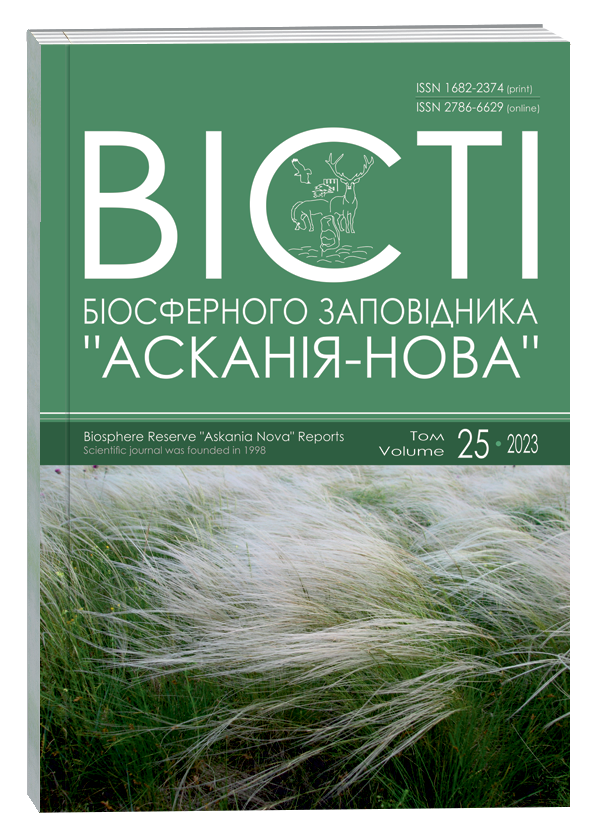MICRO-LEVEL CHANGES IN THE LIVER OF WHITE CARP (STENOPHARYNGODON IDELLA VALENCIENNES, 1844) IN NATURAL AND MODIFIED CONDITIONS OF EXISTENCE
DOI:
https://doi.org/10.53904/1682-2374/2023-25/11Keywords:
Патологія, паренхіма, печінка, токсикантAbstract
The impact of the anthropogenic factor on the hydrosphere has acquired catastrophic proportions. As a result, there is a reduction in the number of populations of aquatic biota. The organism of hydrobionts represents a powerful factor in the accumulation of chemicals in the aquatic environment. It is known that fish are among the first to respond to anthropogenic pressure. Therefore, conducting histological monitoring in order to assess the condition of the body is of great importance. Microanatomical analysis of fish liver sections made it possible to identify organ reactions in the form of impaired blood circulation in the capillaries and dystrophic changes. Compensatory modifications of liver cells are indistinguishable from typical adaptive restructuring of hepatocytes. A modification of functional adaptation can be considered the dedifferentiation of cells under normal living conditions and under the influence of a damaging factor. The first sign of pathological changes in the liver is a violation of microcirculation. With prolonged exposure to toxicants, venous congestion and the phenomenon of stasis are detected. The liver of fish is highly reactive and has a large functional reserve. In transformed living conditions, the functions of the organ are disrupted. The increased fat content in the liver of fish is a consequence of metabolic disorders caused by the action of toxicants. The most common morphological sign of these disorders is a variety of dystrophic changes. With pa-thology of the liver parenchyma of fish, granular, hydropic and fatty degeneration of cells is observed. A slow course of fatty degeneration is characterized by a moderate shift in cellular parameters and local deformation of hepatocytes. In the dynamics of the process, the most severe form of fatty degen-eration occurs – lipophanerosis. The progression of the granular variant provokes the onset of hydropic dystrophy. Fatty degeneration is characterized by the appearance of vacuoles of various sizes in the cytoplasm. Small vacuoles merge to form specific fatty cysts. Their appearance is considered a diag-nostic sign of the degree of liver damage in chronic exotoxicosis. Functional organ failure is accom-panied by an increase in the amount of reticular tissue in the parenchyma. An increase in the content of collagen fibers corresponds to the morphological picture of fibrosis. Numerous transformations of the liver structure are evidence of intoxication of the body, provoke the occurrence of cirrhosis and serve as a specific bioindicator of the state of the environment. The ecological situation in the Azov-Black Sea basin is regarded as unfavorable for the reproduction of aquatic organisms.
References
Антомонов М. Ю. Математична обробка та аналіз медико-біологічних даних. Київ : VMD, 2006. 558 с.
Козий М. С. Оценка современного состояния гистологической техники и пути усовершенствования изучения ихтиофауны : монография. Херсон : Олди-плюс, 2009. 310 с.
Козий М. С. Гистоморфологические особенности ихтиофауны Юга Украины : монография. Херсон : Олди-плюс, 2011. 180 с.
Bashir A., Lan J. P. Hepatic and gonadal lesions in medaka (Oryzias latipes) exposed to trichloroacetic acid as embryos. Proc. IV Internat. Symp. Aquatic Animal Health. New Orleans. ISAAH. 2002. P. 238–239. Beckman B. R. Copper intoxication in chinook salmon (Oncornynchus tshawytsha) induced by natural springwater: effect on gill Na+, K+–ATP-hase, hematocrit and plasma glucose. Fish Acuat. Sci. 1988. N 8. P. 1430–1435.
Bolotova N. L., Konovalov A. F. Morphopathologic analisis of zander (Stizostedion lucioperca L.) in Beloe Lake. 28 Congr. Internat. Ass. Theor. Applied Limnol. Pt. 3. Melbourn. 2003. P. 1609–1612.
Lukin A., Sharova J. Assessment of fish health status in the Pechora river: effects of contamination. Eco-toxicology and Environmental Safety. 2011. Vol. 74(3). P. 335–365.
Parashar R. S., Banerjee T. K. Toxic impact of lethal concentration of lead nitrate on the gills of air-breathing catfish Heteropneustes fossilis (Bloch). Ver. Arh. 2002. Vol. 72(3). P. 167–183.
Simonato J. D., Guedes C. L. Biochemical, physiological and histological changes in the neotropical fish Prochilodus lineatus exposed to diesel oil. Ecotoxicology and Environmental Safety. 2008. Vol. 69(1). P. 112–120.







